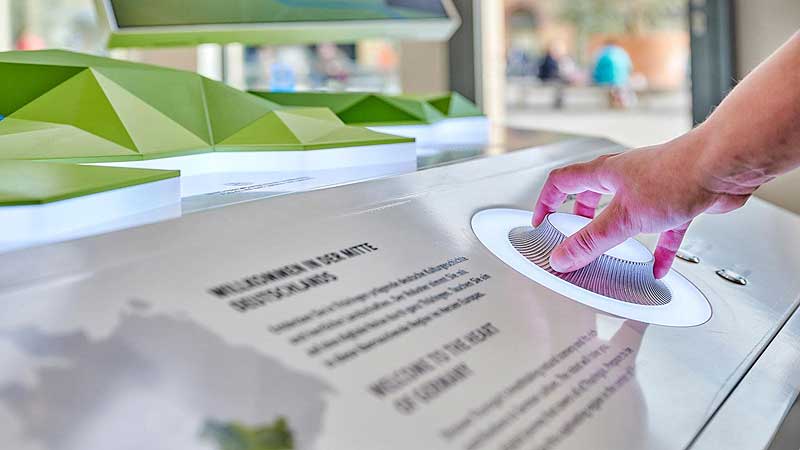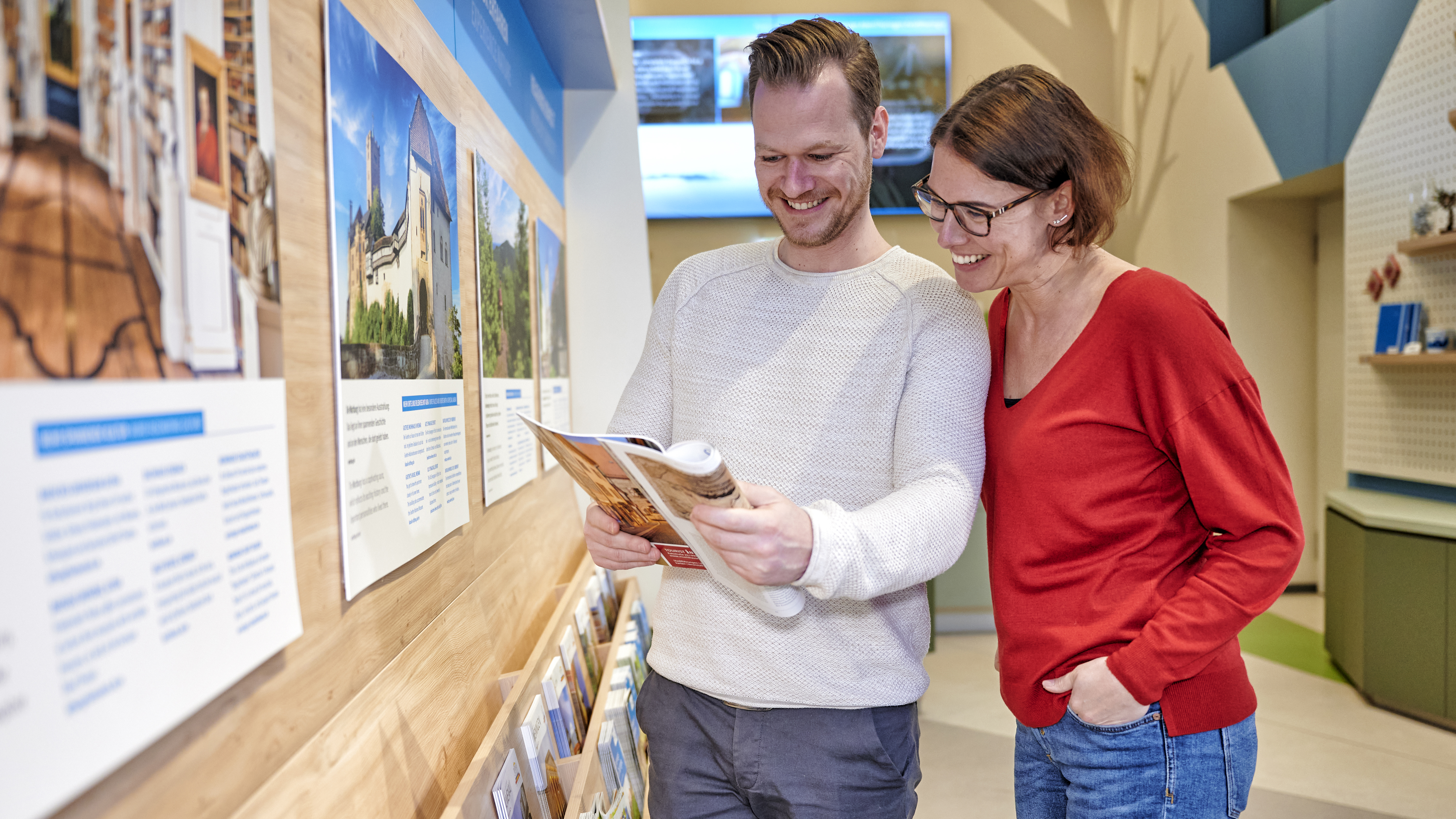Sustainability is on everyone's lips, and it is important. It's about us and our future, about a healthy environment, healthy people, a fair and just world for everyone. Come along and discover good examples in Thuringia – certified spots, sustainabel offers, national natural landscapes and more!
A journey through time – from classical to modernism
The perfect weekend in Weimar
Friday: Salve - greetings!
Travel comfortably by car or by train to the European Capital of Culture of 1999. Choosing an accommodation in the historical city centre might be challenging, but only because of the large variety of available options.
Stay at the stylish traditional “Hotel Elephant”, the renowned “Dorint am Goethepark” or the elegant “Leonardo Hotel”. Or what about the venerable “Grand Hotel Russischer Hof” or the boutique hotel “Schillerhof” with its 19th century reminiscences. Whatever your choice, you will find these places excellent examples of barrier-free comfort, making them ideal starting points for your Weimar discovery tour.
How about opening the weekend in Weimar with an individual guided tour? The certified city guide Olaf Sundhaus will pick you up at the hotel to give
you a first impression of Weimar. The special places of “Classical Weimar” are all close. You will learn about the history and stories hidden behind historical facades in a charming and personal conversation with your guide. Insider tips are included, for example to find a nice and atmospheric restaurant for dinner. And it is not just the above-mentioned hotels that provide barrier-free comfort along with traditional Thuringian or sophisticated international cuisine.
CLASSICAL WEIMAR
Saturday: European cultural history with Weimar classics
Saturday is dedicated to Weimar Classicism and its fascinating details. The Duchess Anna Amalia Library and other sites reveal the zeitgeist of a period when courtly and bourgeois culture came together. Important literary works emerged that carried the spirit of cosmopolitan thinking and humanist aspirations. Proof is provided by the library’s collection, which for 35 years was the responsibility of Johann Wolfgang von Goethe. The best way to spend Saturday morning is hence a prolonged visit to the historic library and its famous rococo hall. For conservational reasons, the number of visitors is limited, so make sure to book your ticket online in advance. The Weimar Tourist Information Office and the library’s ticket office will be pleased to assist you.
PHOENIX FROM THE ASHES: DUCHESS ANNA AMALIA LIBRARY
Following the visit of the magnificent library, it will be time to relax at the ancient market square. Its unique “Weimar charm” comes from this blend of contemplation and vibrant activity. If you are hungry, try the famous Thuringian roasted bratwurst for lunch. Besides, the Weimar Tourist Information Office is also located here. It is worth a visit, and not just for the helpful information that the staff can give you. They know their city best and can help you explore it, from city maps to tickets for “Deutsches Nationaltheater” (German National Theatre), “Weimarhalle”, or one of the many cabaret theatres in town.
The Weimar+ app is the ideal companion for your time in Weimar, whether you want to take a walk through the city and the nearby park Ilm Park or tour of Bauhaus Museum or the Museum Neues Weimar. The app is both entertaining and informative. Not only on site. Anyone who wants to browse through the splendid volumes of the Rococo Hall, which are not accessible for conservational reasons, can use the AR application "Opened!" to digitally take the historical books off the shelves and admire the contents. The app will make you see the Ilm Park as a place of history, and it will turn your stroll into an audio walk experience. On various spots you can enjoy short entertaining and informative audio plays, which makes the park a place to enjoy with all the senses.
Goethe is undoubtedly among Weimar's most notable personalities. A visit to the National Museum dedicated to him is thus a must-see in the afternoon. In terms of accessibility, you should be aware that Goethe's apartment is only accessible via narrow doorways and stairs. The annex's comprehensive permanent exhibition "Floods of Life - Tower of Deeds" is easily accessible on the ground-floor, however. The exhibition shows the original furniture and collection items that illustrate Goethe's many interests beyond his literary work. After this excursion into “Sturm und Drang”, the afternoon comes to a relaxing end. Enjoy the ambience of the small alleyways and squares in the vicinity. In the summer, when the weather is pleasant, it almost feels Italian when visitors and locals sit in the street cafés at Frauenplan square watching the people passing by while enjoying a cappuccino. That must be it, the special Weimar flair! The Erbenhof is also a lovely spot. The quiet inner courtyard tempts you to stay for a while and relax, and the courtyard bakery welcomes you to nibble.
The Ilm Park makes garden fans happy, who want to admire the horticultural ideas of Duke Carl August and Goethe or simply want to enjoy a good dose of greenery in the city. A look at the poet's garden cottage, the Roman House and the Templars' Building gives an impression of the 48-hectare landscape park, which runs through the middle of the city but is also located on the edge of the old town. At dinner in the evening or at the hotel bar, you can unwind and reminisce about the day and look back at your encounters with the Weimar classics in the finest of company.
Sunday: Exploring Weimar’s Modernism Quarter
After a relaxing breakfast, Sunday is all about modernity. It's time to visit the new Weimar Cultural Quarter, which was established in 2019 with the opening of the Bauhaus Museum Weimar and spans the period from the end of the nineteenth century to the present.
Weimar Modernism Quarter
The morning starts with a visit to the Museum Neues Weimar, one of the first German museum buildings. After having been unused for 50 years, the museum was restored to its former condition, expanded, and reopened in 1999. The permanent exhibition in the spectacular neo-Renaissance structure, which opened in 2019, is an ideal starting point for learning about the Bauhaus's precursors, including van de Velde, Harry Graf Kessler, and Nietzsche. The museum illuminates the historical and cultural context that laid the basis for Gropius and his colleagues' well-known teaching methods and early design approaches. At certain dates, visitors to the museum can attend crafts activities such as bookbinding or woodworking.
Following may be a visit to the Café Kunstpause in the museum under the motto “nomen est omen”. It's the perfect place to take a break and enjoy some food in between exhibition tours. The Bauhaus-style café not only serves refreshments in a fashionable setting, but it also offers a fantastic view of the Weimarhallenpark, which during good weather can be enjoyed from the terrace.
The Bauhaus Museum Weimar showcases the world's oldest Bauhaus collection in a massive light grey concrete cube. It evokes the early years of the twentieth century's most prominent design and art school as a space for open interactions and discussions. The exhibition "The Bauhaus comes from Weimar" connects the Bauhaus's history and design suggestions with contemporary and future life-shaping issues. During a visit, it is clear that the Bauhaus was a place of experimentation in art, design, architecture, and education. It's amazing how vivid and familiar the objects and concepts of 100 years ago still appear to us today.
Before this Weimar voyage through time ends and the beautiful weekend concludes, the museum store provides another opportunity to take home literature, presents, or simply memories of Weimar Modernism.
Head picture and photos: ©Florian Trykowski, Thüringer Tourismus GmbH
Discover more ...















